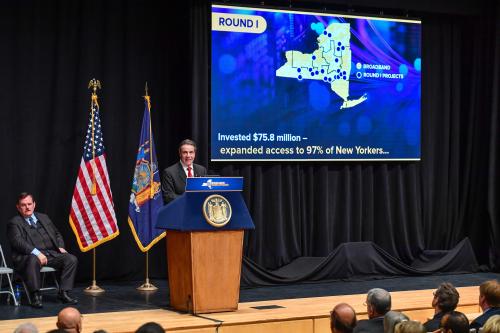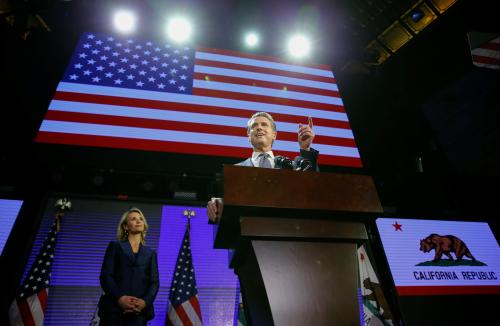Each year, governors outline their legislative and budget priorities in “State of the State” addresses. This is the second in a series of posts that explore what governors are saying in 2019 about issues related to innovation and inclusion. The first can be seen here.
One of the most profound challenges facing the United States today—and a key mobilizing force in American politics—is that the national economy leaves far too many people behind. Challenges to economic inclusion cut across many dimensions. As our Brookings colleagues have documented, larger metro areas are growing quickly, while smaller cities and towns are struggling to keep pace. Meanwhile, stark racial disparities persist at a time when people of color represent the fastest-growing populations within the United States.
To better understand governors’ approaches to closing geographic and racial divides within their states, we examined their State of the State addresses to identify new policy ideas and proposals.
Governors’ ideas to address geographic divides
Nearly every governor in this year’s State of the State addresses expressed a commitment to help their residents succeed regardless of where they live. At least a dozen governors offered tangible proposals to address regional disparities.
Some governors outlined broad approaches. Kansas Governor Laura Kelly described population declines across most rural counties in Kansas and stated, “In the coming days, we will build an interconnected, strategic plan for rural economic development that leverages our communities’ unique assets. That means developing infrastructure, addressing the shortage of affordable housing, and supporting agribusiness.” Meanwhile, North Dakota Governor Doug Burgum championed a “Main Street Initiative” to invest in public services, a learning network, and an annual summit for small towns across the state. And Iowa Governor Kim Reynolds announced the creation of a “Center for Rural Revitalization” within the Iowa Economic Development Authority to focus on “making rural Iowa an even greater priority.”
Other governors proposed significant investments in economically struggling communities. California Governor Gavin Newsom downsized plans for high-speed rail in the state, shifting his focus to a rail link within the Central Valley; this multi-billion-dollar investment will undoubtedly promote economic development in the region. As part of a larger infrastructure investment, Montana Governor Steve Bullock proposed to allocate $44 million to rural communities in Northern and Eastern Montana that are affected by fossil fuel development. South Carolina Governor Henry McMaster proposed creating a $100 million “Rural School District Economic Development Closing Fund” to attract businesses and jobs, while Maine Governor Janet Mills described plans for a $5 million investment in “rural development” to promote economic growth. While these latter two commitments are noteworthy, it’s worth stating that there is a lively debate as to whether traditional business incentives are effective ways to create jobs.
Several governors described plans to leverage Opportunity Zones, which represent the federal government’s latest attempt to revitalize struggling places through tax incentives.
Lastly, several governors described plans to leverage Opportunity Zones, which represent the federal government’s latest attempt to revitalize struggling places through tax incentives. Michigan Governor Gretchen Whitmer announced that she has expanded contracting opportunities for small businesses in designated zones. Meanwhile, Maryland Governor Larry Hogan proposed state tax incentives to make the state’s Opportunity Zones more appealing to investors. This alignment of efforts helps governors achieve more with their state investments.
Governors’ ideas to address racial divides
Few governors explicitly discussed the topic of race in their speeches; even fewer proposed concrete ideas to address racial disparities.
The clearest set of ideas came from Minnesota Governor Tim Walz, who stated, “We must tackle the racial and geographic opportunity gaps in education head on … The budget proposes to fund nearly $8 million new and existing programs designed to attract, prepare, and retain racially diverse, quality teachers in Minnesota’s schools … Additionally, the budget proposes to allocate $4 million in grants to create mentoring, induction, and retention incentives for teachers of color.” New Mexico Governor Michelle Lujan Grisham declared, “Our Native American students will not be left behind … we will hold up this state’s diversity as our strength and our lifeblood,” proposing to double the amount the state spends through the state’s Indian Education Fund and add $55 million for bilingual and multicultural programs.
Nevada Governor Steve Sisolak offered a more structural solution to promoting racial inclusion by declaring his intention to open a “Governor’s Office for New Americans,” which will serve a predominantly minority population. Sisolak noted that the office is intended to “help our newest neighbors … navigate government services, build new businesses, and let them know that they are welcome here,” as well as provide assistance to DACA recipients and applicants. Other governors, including Wisconsin Governor Tony Evers and New Jersey Governor Phil Murphy, also identified racial disparities as a severe challenge.
At least 14 governors, both Republicans and Democrats, pledged substantial reforms to their state’s criminal justice system.
There was notable bipartisan agreement on criminal justice reform, an issue inextricably intertwined with race. By our count, at least 14 governors, both Republicans and Democrats, pledged substantial reforms to their state’s criminal justice system. Citing a range of motivations including racial justice, fairness, opportunities to boost economic growth, and management of the cost of corrections, these governors championed new programs to provide mental health services, substance abuse prevention, skills training, and re-entry assistance for incarcerated and formerly incarcerated people. New York Governor Andrew Cuomo and Iowa Governor Kim Reynolds offered particularly nuanced proposals for reforming their state’s criminal justice systems, including by eliminating cash bail and shielding employers who hire workers with criminal backgrounds from liability.
Collectively, these governors’ statements suggest an awareness that economic disparities—particularly between different parts of their state—are an urgent concern. In addition to the proposals mentioned above, their calls to expand educational resources, increase medical coverage and keep costs under control, treat the opioid epidemic, and many other ideas hold great potential for achieving economic inclusion.
Ideas abound for addressing disparities between people and places, should state leaders choose to consider them. Strategies could include mobility and commuter subsidies, more generous “adjustment” benefits, or even targeted investments in networks of mid-size cities across their state. Given states’ elevated policymaking role today, the policies that state leaders adopt can serve as models for inclusion across the nation.
The authors would like to thank Andrea Garcia for her contributions to this analysis.







Commentary
Governors’ strategies for geographic and racial inclusion
March 26, 2019